|
Clogged Sprinkler Heads...
Jason Hooper, Quilchena Golf Club, Quilchena, BC:
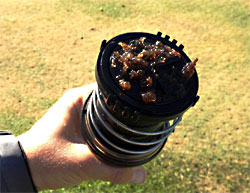
pond scum clogging sprinkler heads
|
 "I'm pleased to report that we've resolved the irrigation pump station issues we were recently experiencing that resulted in some severely stressed turf on the course, particularly on our fairways. They are recovering nicely, but not as quickly as they should be. There's a reason for the slower than anticipated recovery: clogged sprinkler heads. While monitoring the operation of the irrigation system we began seeing pressure issues again. When further pump station issues were ruled out, we discovered that the screens on the bottom of each sprinkler head are becoming clogged with pond scum from the irrigation pond. Here is a photo of exactly what we're finding:
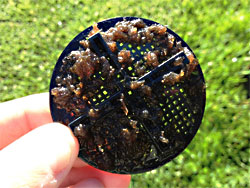
difficult to effectively irrigate turf with this issue
| 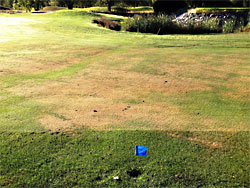
resulting turf stress from clogged sprinkler heads
|
Needless to say, sprinkler heads clogged this badly will not operate properly and turf stress and even turf loss are unavoidable until they are back in proper working order.
At this time, the only way to effectively eradicate this problem is to test each sprinkler head and physically remove the "guts" from those experiencing pressure issues to flush and clean these clogged screens. Needless to say, this is a time consuming process (anywhere from 6-12 minutes per sprinkler head, depending on how badly clogged they are) that has now moved to the top of our priority list. With over 1200 sprinkler heads on the golf course, this isn't something that gets fixed overnight."
Visit Jason's blog at qgolfclub.blogspot.ca.
|
 |
|
Fall is Here (and some very strange dead spots)...
Rob Dorsch, CGCS, Richter Park Golf Course, Danbury, CT:
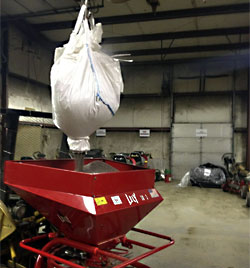
Fall Fertilizer
|
 "It has been a while since the last update and overall we are surviving the season and moving into fall with a great foundation for success. Fall is a time for recovery and seeing how we started the season on March 14th with guns a blazing it feels good to make it to the finish line. We have applied the 1st of 2 organic fertilizer applications to our fairways and now really start focusing on putting the course to sleep. While we experienced some bumps and bruises along the way, especially on 6 and 7 greens we will move on to bigger and better next year.
Currently we are fighting forces other than Mother Nature. On #12 Green you will see numerous dead spots. These are all from our resident Blue Heron deciding to use the green as a personal toilet. The spots are dead for sure and we will begin plugging them out very soon. We will be spiking, verticutting and topdressing this week so the spots will not be as visible and then will attempt to start scaring our flying friend to other pastures.
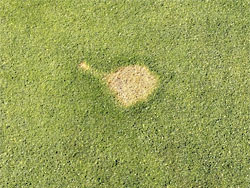
#12 Green
| 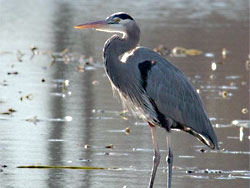
Blue Heron
|
We will not be core aerifying until the last week in October and then we will deep tine two times during the month of November. These cultural practices will help develop deep roots and encourage proper drainage during the freeze thaw of winter."
Visit Rob's blog at richterparkturf.blogspot.com.
|
 |
|
Funny-Looking Trees...
Rick Tegtmeier, CGCS, Des Moines Golf & CC, Weest Des Moines, IA:
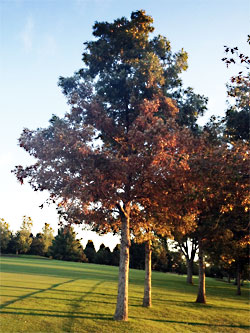  "I have had a lot of questions the last few weeks as to why some of the trees have their bottom leaves looking burnt or brown.
Here at DMGCC we have a well that supplies all of our irrigation water. This well is very deep (2,808 feet). Water coming from a depth this deep is not known to have high quality. It has very high bicarbonates and salts in the water.
When you use it for our irrigation needs the sprinklers hit the lower branches of the trees. As the water dries on the leaf it will leave these salts and bicarbonates on the leaf. If there is no fresh rain water to wash them off then the salts will do what they normally do. Salt will dehydrate and burn the leaf leaving them with the look that we currently have. Needless to say we need some moisture, however the damage to the leaves for this year is already done."
Visit Rick's blog at dmgcc.blogspot.com.
|
 |
|
Edging bunkers...
Pat Quinlan, Madison Golf Club, Madison, NJ:
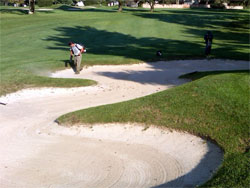
#3 Bunker edging in progress
|
 "The crew is working on edging more of the bunkers today. They started last week and were able to finish the bunkers at the 1st and 9th greens and the 2nd fairway bunker. The weekend storm delayed the edging of the bunkers until today so we hope to complete the bunkers at 3 and 6 greens today while finishing the rest of the bunkers next week.

#9 Bunker edge complete.
|
The greens are drying down and firming up, allowing us to groom them frequently picking up speed and trueness. Certain approaches and collars that remain wet are suffering with the cooler and wetter weather causing turf decline and leaving thin areas. The aeration starting on Sept. 24th will aid in the recovery of these areas. These areas that are extremely thin will be aerated a second time around mid-October. Over-seeding will take place after both aerations.
Please remember to fix your ball marks, fill your divots, put the flagsticks back in the hole, and tap your shoes upon exiting the bunkers. These simples procedures are every players responsibility and allow for the golf course to be in great shape for every member and guest."
Visit Pat's blog at mgcgreens.blogspot.com.
|
 |
|
Got Grubs?
John Slade, Laurel Creek Country Club, Mt. Laurel, NJ:
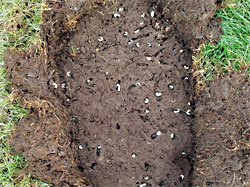
These guys aren't feeling too good after a control product was applied this week.
|
 "This week's surprise came when we discovered some bluegrass rough that peeled back like an area rug in your house. The cause of this was easy to identify: Grubs.
Grubs are the larvae stage of scarabs (beetles), and they eat turf roots... which is obviously not good. If you see turf that is wilting despite good soil moisture, you can give it a tug and see if it is well-rooted, or not. Secondary damage to the grass can occur when animals such as crows, raccoons, and skunks start tearing at the turf to find the yummy grubs.
"The strange thing is that we haven't seen grub damage in many years..." |
The strange thing is that we haven't seen grub damage in many years. A preventative application is made in late June, and to date, has been very successful in controlling these insects. There are several possible causes for the lack of control this year, including the timing of application, misses by the applicator, lack of timely precipitation/irrigation to move the product to the soil, or product failure.
For now, a curative application has been made to areas where we have found grub activity. Going forward we will re-evaluate our timing and control methods."
Visit John's blog at http://laurelcreeksuper.blogspot.com
|
 |
|
Chemistry management and aerification recovery...
Matt Crowther, CGCS, Mink Meadows Golf Club, Martha's Vineyard, MA:

"A little over a week after aerifying and topdressing greens and approaches the grass has grown through it all and is back to normal. One superintendent I used to work for compared it to open heart surgery and said "you wouldn't expect a patient to be 100% the next day, would you?" There are many details that go into having a successful cultural practice such as aerifying and topdressing:
The amount of moisture in the soil has a big impact on how the tine penetrates and the effectiveness of the entire process. Too wet and the machine can leave ruts that will impact ball roll and also impact the ability to work the topdressing. Too dry and the green could wilt during the process and be too hard to have a good impact.
"One superintendent I used to work for compared it to open heart surgery and said 'you wouldn't expect a patient to be 100% the next day, would you?'..." |
The weather is huge. I have explained how aerification is best done dry: if cores are pulled they clean up better dry, topdressing works into the turf better dry when either brushed or blown and also faster. If the sand is wet in storage — which most of it is unless you purchase kiln dried and store it in a silo or building — so you need to leave it on the surface to dry and the longer that takes the longer the entire process.
The overall health of the turf to start with. If you have a weak, shallow-rooted turf and then attempt to aerify and topdress all of the mechanical stresses of driving on it, dragging a brush, the abrasiveness of the sand etc will all take a toll and potentially give a product that is worse than when you started.
Fertility level. The addition of topdressing sand is to aid in smoothing the surface, protect the crown of the plant, break down thatch, amend the soil, and all of this needs to happen below the very surface of the grass. We want the sand to get off the surface as fast as possible. If the greens are not growing this will slow that process.
Modern greens management relies on growth regulation. We start off in the spring applying chemicals to suppress seed heads, and continue using chemicals, often on a weekly basis, to suppress vertical growth. This regulation is what gives you not only faster speeds but also consistent speeds throughout the day.
"We carefully monitor clipping yield to gauge how much suppression the grass is under..." |
We carefully monitor clipping yield to gauge how much suppression the grass is under. When you come off regulation and add fertilizers the grass will explode in growth from the added fertility and the "rebound" coming out of regulation. If properly timed this could be a good thing as you witnessed here. We had a slow first couple of days because of the weather and our ability to work the sand into the turf. Once we were over that the turf was growing in leaps and bounds. If you had the misfortune to play Monday morning you witnessed first hand what I am talking about.
The mowers used in the beginning to mow off the initial sand take a beating and need to be sharpened after each use. It took a couple hours to get that done Monday morning so long wet greens were more like putting on fairways.
By Wednesday we had applied our growth regulator and mowed them a few times with the regular cutting units and they were back to normal. Within seven days of aerifying you could scarcely find a hole they had filled in so much. I double cut them today and they look as good as ever so the timing of the flush was successful.
"Did all the staff show up? All the equipment run properly?" |
Luck. Did all the staff show up? All the equipment run properly? (not only the ones used in the process but the others on the course.) No calamities the night before like a sprinkler sticking on (1st green this year) and flooding the green, branch fall on something? You get the idea... anything that will take your attention and manpower away from the task at hand.
Visit Matt's blog at minkmeadows.blogspot.com.
|
 |
|
Now we can rest...
Ken Thompson, Greate Bay Country Club, Somers Point, NJ:
  "After aeration, many members have told me that I must be happy that things are slowing down and that I can rest. I wish!
Things never slow down. Although we were able to finish the green and fairway aeration last week, we still have a lot to do. Our season and work is far from over.
This week we began tee aeration, which we do 'in play', by doing just a few tee boxes at a time on each hole, shifting the tee markers back and forth to the ones we are not working on. This method is time and labor consuming, and will take us a few weeks to finish.
"...we still have a lot to do. Our season and work is far from over." |
Meanwhile, we are re-seeding the rough areas that thinned over the summer, and overseeding the fairways with bentgrass. This too, is a slow, but methodical process. When we finish these we will overseed the tees with bentgrass.
We are beginning "spring" weed control. Most weeds are best controlled in the fall so that they won't become a problem the next coming spring. We have started to spray out broadleaf weeds such as clover, plantains, dandelion, etc. We have to coordinate these sprays with seeding because the herbicide will also kill any new seedlings that we have seeded, so there is a lot of planning and timing involved.
When these are finished it will be time to aerate the rough — a job that takes 3-4 weeks.
We also plan to lime the fairways to bring our calcium levels up. This will be a huge job — spreading about 3 tons lime per acre.
Slow down? Rest? We probably won't until there is six inches of snow on the ground..."
Visit Ken's blog at greatebaycc.blogspot.com.
|
 |
|
About our Blog Aggregator: Many superintendents are now hosting private blogs to better communicate with their golfers and/or members. Beyond local weather and course conditions, there is a great deal of information about projects, methodologies and techniques that would be of value to other superintendents — hence our Turf Blog Aggregator. As every blogger struggles occasionally with content, we also include posts intended to educate golfers about turf maintenance for others to use as a template for their own blogs.
Miss any previous issues of TBA? You can find them all here.
Turf Blog Aggregator(TM) is a trademark of Turnstile Media Group.
|
|